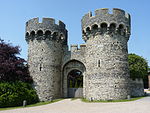Dalham Farm
Geological Conservation Review sitesSites of Special Scientific Interest in Kent

Dalham Farm is an 8.8 hectares (22 acres) geological Site of Special Scientific Interest in High Halstow, north of Rochester in Kent. It is a Geological Conservation Review site.The farm shows mass movement of rock and soil on a shallow 8% slope of London Clay, which is seen in ridges across the site. It may be the lowest angled slope failure in Britain, and is important in demonstrating slope degradation where there is no coastal erosion.A public footpath crosses the site.
Excerpt from the Wikipedia article Dalham Farm (License: CC BY-SA 3.0, Authors, Images).Dalham Farm
Cooling Road,
Geographical coordinates (GPS) Address Nearby Places Show on map
Geographical coordinates (GPS)
| Latitude | Longitude |
|---|---|
| N 51.449 ° | E 0.557 ° |
Address
Cooling Road
Cooling Road
ME3 8SF , High Halstow
England, United Kingdom
Open on Google Maps










